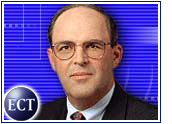The U.S. Commerce Department is looking at electronic commerce to provide the primary economic growth for the United States over the next 100 years, but at the same time, the agency has not yet figured out how big an impact Internet business has had on the country to date.
Commerce’s Office of Electronic Commerce released its second annual report, “The Emerging Digital Economy II,” yesterday, with a small amount of fanfare from Vice President Al Gore. As he has revved up his bid in recent weeks for the Democratic nomination for President, Gore has been trying to take credit for the online commerce boom, which has contributed to the United States’ overall economic prosperity during President Clinton’s years in office.
Political Spin
Though Gore put his name on the introduction of the new, largely upbeat e-commerce report, it was primarily the product of Commerce Secretary William Daley and Undersecretary for Economic Affairs Robert Shapiro. Appropriately for an appointee in the technology-happy Clinton Administration, Daley hailed the study as “fresh evidence that our Nation’s massive investments in these sectors are producing gains in productivity and that these sectors are creating new and higher paying jobs faster than any other sector.”
Information technology businesses still contribute less than one percent of the country’s overall economic production, the study notes. “While the numbers are still small, when compared to our overall economy, they are growing more rapidly and provide more evidence that electronic commerce will be the engine for economic growth in the next century,” Daley added.
The Commerce Department draws some conclusions about the growth of various businesses within the e-commerce and IT sectors, but Daley is careful to also point out that the industry is still too young for the government to determine its overall impact on the U.S. economy. Noting the department will continue to conduct these studies annually, he called on input from private and non-profit businesses and academic institutions to analyze further data as it comes in.
Not So Shocking Stats
Among its more obvious observations, the report says producers of computer and communications hardware, software and services to enable e-commerce “play a strategic role in the growth process.” In other words, without computers, e-commerce would not go far.
More interestingly, IT producers accounted for just 8 percent of U.S. gross domestic product from 1995 through 1998, but they accounted for 35 percent of the nation’s economic growth. In 1996 and 1997, falling computer equipment prices brought down the country’s overall inflation rate by an average of 0.7 percent per year.
This growth is expected to have a major impact on the U.S. workforce, according to the study, which estimates that by 2006 almost half of all American workers will be employed in the IT sector. As a result of that demand, “wage gaps between workers in IT industries and all other workers continue to widen,” the report states.
In the global e-commerce market, the United States continues to lead, but that lead is narrowing as other countries increase their focus and infrastructure investments. “Although the number of Internet users in the United States and Canada continues to grow, the U.S. and Canadian share of world Internet users has declined from 62 percent in 1997 to 57 percent in May 1999,” according to the report.






































Social Media
See all Social Media